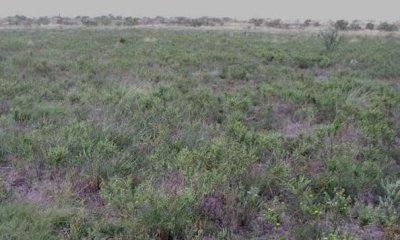
Lakebed 12-17" PZ
Scenario model
Current ecosystem state
Select a state
Management practices/drivers
Select a transition or restoration pathway
-
Transition T1A
Prolonged excessive grazing pressure and drought conditions
More details -
Restoration pathway R2A
Adequate rest from defoliation and release from drought conditions
More details -
Transition T2A
Prolonged excessive grazing pressure and extreme drought conditions
More details -
Restoration pathway R3A
Adequate rest from defoliation and release from drought conditions
More details -
No transition or restoration pathway between the selected states has been described
Target ecosystem state
Select a state
Description
The (1.1) Shortgrass/Midgrass Community is the interpretive or "reference" plant community for the dryer phase of the Lakebed site. The typically plant community during normal to extended dry periods was dominated by buffalograss and vine mesquite, with lesser amounts of blue grama, cane bluestem, western wheatgrass, and white tridens. These grasses made up approximately 70% of the total site production. More commonly found forbs were curlycup gumweed, western ragweed, plains coreopsis, snow-on-the-mountain, silverleaf nightshade, and numerous annuals accounting for approximately 30% of the site production. Woody plants were not common on this site.
With moderately frequent and prolonged inundation, the warm season short/midgrass species will be replaced with sedges, rushes and emergent hydrophytic vegetation. This site will transition into the (1.2) Grasslikes/Forbs/Annuals Community – wetter phase), generally devoid of drier phase grasses. Grasslike species of this community are predominantly sedges, creeping spikerush, and knotgrass. Emergent hydrophytic forbs are typically smartweed, arrowhead, curly dock, and frogfruit.
Submodel
Description
Bottlebrush squirreltail, and annual grass species such as little barley and barnyardgrass, can invade the site and increase dramatically. Buffalograss and other shortgrass species will be in low vigor with few midgrass species remaining. Bare ground can exceed 40% with annuals filling the voids. Herbage production declines as shorter plants with shallow root systems dominate. The approximate total annual production ranges from 500 to 1,800 pounds per acre.
Submodel
Description
Further degradation of the dryer phase Lakebed site, caused by continued overgrazing and prolonged drought will move this site towards the (3.1) Degraded Shortgrass/Annuals Community. Annual forbs and grasses will dominate with small colonies of low vigor buffalograss scattered throughout the site. No midgrass species remaining with large areas of bare ground covering >50% of the site. The approximate total annual production of this degraded state will range from 600 to 1,700 pounds per acre with annual forb production exceeding perennial and annual grass production.
Submodel
Mechanism
If long term abusive grazing does occur on the dryer phase lakebeds this site tends to move towards the (2.1) Shortgrass/Annuals Plant Community.
Mechanism
With prescribed grazing, pest management, and occasional short-term, light flooding, this site can return to state 1.
Mechanism
Further degradation of the dryer phase Lakebed site, caused by continued overgrazing and prolonged drought will move this site towards the (3.1) Degraded Shortgrass/Annuals Community.
Mechanism
With the implementation of Prescribed Grazing (growing season rest), Pest Management, and Short Periods of Inundation, the Degraded Shortgrass/Annuals State can be restored to the Shortgrass State.
Relevant conservation practices
| Practice | External resources |
|---|---|
|
Prescribed Grazing |
|
|
Integrated Pest Management (IPM) |
Model keys
Briefcase
Add ecological sites and Major Land Resource Areas to your briefcase by clicking on the briefcase (![]() ) icon wherever it occurs. Drag and drop items to reorder. Cookies are used to store briefcase items between browsing sessions. Because of this, the number of items that can be added to your briefcase is limited, and briefcase items added on one device and browser cannot be accessed from another device or browser. Users who do not wish to place cookies on their devices should not use the briefcase tool. Briefcase cookies serve no other purpose than described here and are deleted whenever browsing history is cleared.
) icon wherever it occurs. Drag and drop items to reorder. Cookies are used to store briefcase items between browsing sessions. Because of this, the number of items that can be added to your briefcase is limited, and briefcase items added on one device and browser cannot be accessed from another device or browser. Users who do not wish to place cookies on their devices should not use the briefcase tool. Briefcase cookies serve no other purpose than described here and are deleted whenever browsing history is cleared.
Ecological sites
Major Land Resource Areas
The Ecosystem Dynamics Interpretive Tool is an information system framework developed by the USDA-ARS Jornada Experimental Range, USDA Natural Resources Conservation Service, and New Mexico State University.




